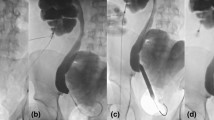Abstract
The aim of this study is to investigate the impact of the intentional ureteral stenting on the success rate of calculus extraction by second ureteroscopy, when the initial ureteroscopy failed. We prospectively enrolled 512 patients with ureteral calculi who underwent ureteroscopies from April 2005 to May 2011. The patients with failed initial ureteroscopies were classified into two groups depending on the stent type: the Double-J stent and the ureteral catheter group. The secondary ureteroscopies were performed in a short period (3–22 days). Data were abstracted on stone size, location, patient demographics, outcome and complications. A total of 453 patients had success after the initial ureteroscopy and the success rate was 88.5 %. Of the 59 failed patients, 40 were managed by reureteroscopy with Double-J stent placement and 19 with ureteral catheters. There were no statistically significant differences between patients in Double-J stent and ureteral catheter group in the aspects of age, primary stone size, gender, stone location and stone-free rate [39/40 (97.5 %) versus 19/19 (100 %), p > 0.05]. Moreover, the mean stents retaining period before the second ureteroscopy was significantly shorter in the ureteral catheter group, when compared with the Double-J stent group (3.9 versus 16.9 days, p < 0.01). The complications were moderate and not significantly different between the two groups (p > 0.05). Indwelling a ureteral stent leads to a high subsequent success rate for second ureteroscopy following an initial failed procedure. In addition to Double-J stent, the ureteral catheter stent was an effective alternative with shorter retaining period, especially for impacted stones.

Similar content being viewed by others
References
Tombal B, Mawlawi H, Feyaerts A et al (2005) Prospective randomized evaluation of emergency extracorporeal shock wave lithotripsy (ESWL) on the short-time outcome of symptomatic ureteral stones. Eur Urol 47:855–859
Kranbeck A, Murat F, Getman M et al (2006) The evolution of ureteroscopy: a modern single institution series. Mayo Clinic Proc 4:468
Ryan PC, Lennon GM, McLean PA, Fitzpatrick JM (1994) The effects of acute and chronic JJ stent placement on upper urinary tract motility and calculus transit. BJU Int 74:434–439
Leventhal EK, Rozanski TA, Crain TW, Deshon GE (1995) Indwelling ureteral stents as definitive therapy for distal ureteral calculi. J Urol 153:34–36
Shields JM, Bird VG, Graves R, Gomez-Marin O (2009) Impact of preoperative ureteral stenting on outcome of ureteroscopic treatment for urinary lithiasis. J Urol 182:2768–2774
Best SL, Nakada SY (2011) Flexible Ureteroscopy is effective for proximal ureteral stones in both obese and nonobese patients: a two-year, single-surgeon experience. Urology 77:36–39
Chew BH, Denstedt JD (2007) Ureteroscopy and retrograde ureteral access. In: Wein AJ, Kavoussi LR, Novick AC et al (eds) Campbell-Wash urology, vol 2, 9th edn. Saunders Elsevier, Philadelphia, p 1511
Rubenstein RA, Zhao LC, Loeb S et al (2007) Prestenting improves ureteroscopic stone-free rates. J Endourol 21:1277–1280
Chu L, Farris CA, Corcoran AT et al (2011) Preoperative stent placement decrease cost of ureteroscopy. Urology 78(2):309–312. doi:10.1016/j.urology.2011.03.055
Jones BJ, Ryan PC, Lyons O, Grainger R, McDermott TED, Butler MR (1990) Use of the double pigtail stent in stone retrieval following unsuccessful ureteroscopy. BJU Int 66:254–256
Abdelrahim AF, Abdelmaguid A, Abuzeid H, Amin M, Mousa E, Abdelrahim F (2008) Rigid ureteroscopy for ureteral stones: factors associated with intraoperative adverse events. J Endourol 22:277–280
Aynehchi S, Samadi AA, Gallo SJ, Konno S, Tazaki H, Eshghi M (2002) Salvage extracorporeal shockwave lithotripsy after failed distal ureteroscopy. J Endourol 16:355–358
Anagnostou T, Tolley D (2004) Review, management of ureteric stones. Eur Urol 45:714–721
Peschel R, Janetschek G, Bartch G (1999) Extracorporeal shock wave lithotripsy versus ureteroscopy for distal ureteral calculi: a prospective randomized study. J Urol 162:1909–1912
Singal RK, Razvi HA, Denstedt JD (1998) Secondary ureteroscopy: results and management strategy at a referral center. J Urol 159:52–55
Muslumanoglu A, Alikaradag M, Tefekli AH, Altunrende F, Tok A, Berberoglu Y (2006) When is open ureterolithotomy indicated for the treatment of ureteral stones? Int J Urol 13:1385–1388
Wiseman JL (1934) Observations of the stimulating influence of temporary rubber splinting on regeneration following ureteral resection. BJU Int 6:11–26
Drake WM, Carroll J, Bartone L et al (1962) Evaluation of materials used as ureteral splints. Surg Gynecol Obstet 114:47–51
Hubert KC, Palmer JS (2005) Passive dilation by ureteral stenting before ureteroscopy: eliminating the need for active dilation. J Urol 174:1079–1080
Brookes ST, Donovan JL, Wright M et al (2004) A scored form of the bristol female lower urinary tract symptoms questionnaire: data from a randomized controlled trial of surgery for women with stress incontinence. Am J Obstet Gynecol 191:73–82
Conflict of interest
The authors declare that they have no conflict of interest.
Author information
Authors and Affiliations
Corresponding author
Rights and permissions
About this article
Cite this article
Ji, C., Gan, W., Guo, H. et al. A prospective trial on ureteral stenting combined with secondary ureteroscopy after an initial failed procedure. Urol Res 40, 593–598 (2012). https://doi.org/10.1007/s00240-012-0476-0
Received:
Accepted:
Published:
Issue Date:
DOI: https://doi.org/10.1007/s00240-012-0476-0




